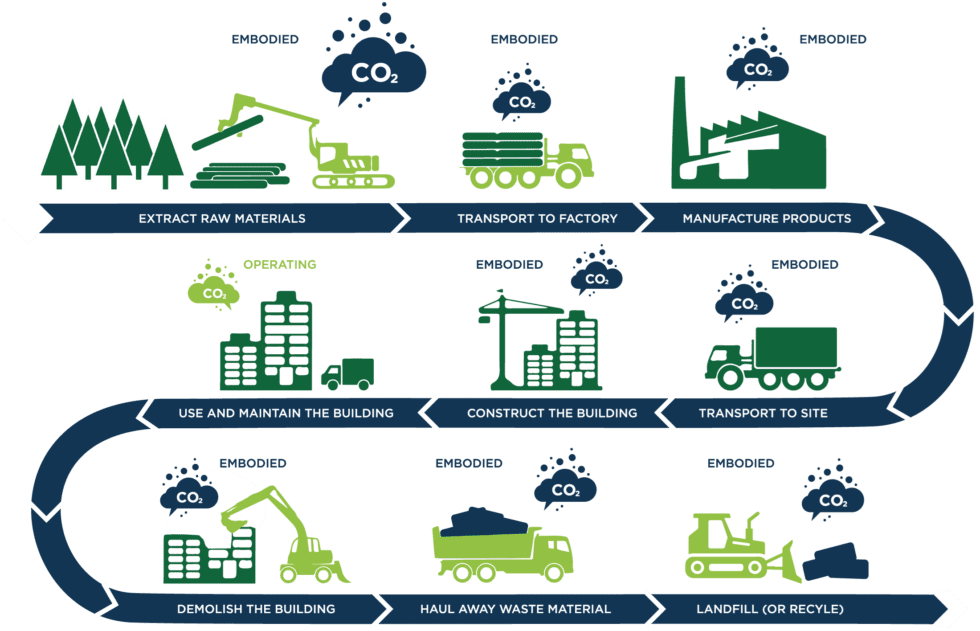Accounting for around 37% of global emissions, the construction sector is by far the largest emitter of greenhouse gases, making it a high priority to decarbonise.
At CFP Energy, we provide tailored sustainable energy solutions. From Voluntary Carbon Credits (VCM) to Power Purchase Agreements (PPAs), we can help you decarbonise your construction sector emissions. Contact one of our carbon specialists today to start your Net Zero journey.
Tackling Embodied Carbon: Materials & Design
Understanding Embodied Carbon
Embodied carbon refers to the emissions associated with construction materials like cement and steel. More specifically, embodied carbon refers to the carbon emissions emitted in the extraction of the raw material, as well as its manufacturing and transport to the site.
Prioritising Lower-Carbon Materials
To reduce embodied carbon, developers should replace materials like steel with recycled versions made from steel waste. It may also be possible to replace building components, such as I-beams, with those made from more sustainable materials.
For instance, laminated timber, sourced from FSC and PEFC certified forests, can make an ideal substitute for steel or aluminium due to its natural ability to sequester carbon.
This makes it an ideal choice for low-rise buildings where flexibility is more critical than high tensile strength, or where design principles demand organic materials.
Adopting Circular Economy Principles
The circular economy prioritises the reuse of materials, preventing the over-extraction of natural resources and reducing the number of usable materials that end up in landfill. Within construction, this means allocating materials for future projects rather than sending them to landfill.
Developers can also help support the circular economy by using ‘material passports’. Passports like these help track components throughout their journey, ensuring that on-site components are reused as much as possible.
Material banks, designed to track and store reusable materials for exchange, can also be beneficial in reducing waste within construction by supporting a ‘closed-loop’ system of sustainable reuse.
How to Reduce Carbon Emissions on A Construction Site
Utilising Cleaner Power Sources
Apart from materials, energy, whether purchased or generated on-site, is almost always the largest source of CO₂ within the construction sector. To reduce CO₂, developers should transition to renewables, whether through power purchase agreements (PPAs), or renewable energy certificates (RECs) or voluntary carbon initiatives.
Minimising Construction Waste
Construction waste is another area where energy usage can be reduced. By implementing digital material tracking, for instance, companies can prevent over-ordering issues that lead to unnecessary waste. Meanwhile, through waste management programmes, construction firms can achieve much higher recycling rates, diverting waste materials from landfill and supporting circular economy principles.
Optimising Site Logistics
Another area to gain carbon reductions is site logistics. Companies that optimise their transport network, whether through consolidated deliveries or local material sourcing to cut down on transportation distances, can significantly reduce their CO₂ emissions.

Powering Carbon Reduction in Construction
Emphasising Reduction First
To ensure emissions reductions are additional and long-lasting, decarbonisation strategies should lie at the forefront of business planning. By taking a ‘reduction first’ approach, construction companies can build sustainable action into every part of their roadmap - from materials selection at the design stage to procuring sustainable fuels for the delivery stage, while securing power purchase agreements to secure energy prices long term.
Measurement & Addressing Residuals
A further way to effectively decarbonise is to monitor and trace carbon emissions through the Lifecycle Assessment (LCA). This assessment protocol can be used to track embodied as well as operational emissions throughout a project’s lifespan.
Carbon audits, such as the PAS 2080 carbon audit global standard, can also be used to identify areas where further emissions reductions can be achieved.
Building a Sustainable Construction Future
The construction sector, compared to others, is the biggest emitter of carbon emissions. To resolve this issue, coordinated action and a joined-up approach are required, from selecting the most sustainable materials to streamlining logistics and on-site operations.
At CFP Energy, we’re here to support you in your carbon emissions reduction goals. From long-term energy procurement (PPAs) to carbon compliance (ETS), we tailor solutions to suit your needs.
Contact our carbon specialists to discuss your decarbonisation goals today.